Ice flowers of the Electric Moon
The boundary between summer and fall is always elusive in this part of Texas, more than usual this October as cool nights have you reaching for your jacket in the early morning and the sunny afternoons have you reaching for your shorts. The ground is littered with falling leaves, the woods start to open up, and the sky begins to take on that crisper blue that goes with the authentically cold. But some of the flowers only now get around to blooming, many of them species adapted to the migrating butterflies you see everywhere you look in the afternoon. The sawtooth sunflowers my son and I transplanted in May, gift of a guerrilla gardener friend who sometimes arrives at our gate with a trunkload of rare plants ripped from some lot about to be razed, finally exploded in yellow this week. I guess it just needed those autumn rains to push it over.
Some of the plants give you a clearer sign of the season to come. The winter bromes, bane of the native gardener, are coming up all over the pocket prairie and the forest floor, daring you to burn them out. And in the neglected margins of the yard, the parts that still have the brutish character of an empty lot, the frostweed is in bloom. Before it flowers, you might easily mistake its big green leaves for some cousin of the ragweed that grows in similar spots. But when you see the afternoon honeybees and skippers cavorting on its lush shag of white blossoms, you get an immediate appreciation of the bounty it provides as the last vestiges of the warm half of the year bleed off into the cooling sky. Especially when you witness it on a day when the morning paper delivered a report of how endangered some bee species are.
Frostweed is a species it took me a while to learn to appreciate. It tends to do best in empty lots like the ones to the east of us, often in the shady cover of beat-up trees, with meaty dark leaves that make it look like some rogue tobacco that would cause you to lose your mind if you cured it and smoked it. When cold arrives for real, cold that freezes the condensation, the stems sweat ice crystals, turning the edgeland behind the door factory into a surrealist sculpture garden. I walked through that morning fantasia for a few years before I even realized it was a known characteristic of this particular plant.
Maybe it was that call of the coming uncanny that induced me to head out into that empty lot next door on Wednesday night, hunting for the Hunter’s Moon. Walk When the Moon is Full, Frances Hamerstrom taught her kids, and she was right, even if the idea of walking in the woods at night terrifies my inner child as well as my outer adult. There’s a rigorous discipline to confronting that fear, preferably without a flashlight.
I set out early, right after we got our daughter to bed. The moon had only just begun to rise, still so low you couldn’t see it behind the trees and factory rooflines to the east of our home. That meant the woods were still inky dark, but even then your eyes adjust pretty quickly. So do your ears, warning you of every rustle in the brush. You convince yourself the snakes are all tucked away underground for the season, and the coyotes would not bother with some little dude who wears a 36-short jacket when there are plenty of deer. Then you remember how this particular full moon, the one that comes after the harvest and before Halloween, is associated with the season when the animals get out at night to fatten themselves up for winter.
The tallgrass was drying out but still thick underfoot, much thicker in some patches than others, so you never knew how much it would give with each step. The old right of way that runs into the woods past the gate where the road ends was thick with frostweed, and those white blossoms acquired an eerie quality in the bluish light of the LED lamps shining faintly from the roof of the door factory. The spiders had been busy, and as I pushed through the brush, that light wasn’t enough to keep me from running into a few face grabbers whose webs I had to wipe off like sticky stray hairs.
Behind the gypsum board supply depot, the Johnson grass was still too tall and dense to easily walk over. That’s a weird little vector in there, a triangle of land above the ravine where a drainage ditch empties and right before the flat field I was trying to get to opens up. I’ve seen foxes trotting back into that zone often, which makes me think that’s where they den. As I tried to find a path, I heard the snorts of some nearby deer warning each other of my clumsy creeping, which gave me a bit of a jolt.
I’ve walked through that brush patch hundreds of times, but never in the dark, and it was more disorienting than I expected, as the foliage changes the available pathways week to week. So I tried following the fence that separates factory from forest, only to have to get down on my knees to get through the last few yards, where the retama killed by February’s winter storm had blocked the usual way. Thinking I had found the tunnel out, I crawled into the canopied understory of another tree, and found myself in what looked an awful lot like the den of some bigger animal. Lawyer crawling backwards is the name of that pose.
When I finally emerged and reclaimed my putative status as a bipedal apex predator, I saw the full moon coming up above the dairy plant. It was not as epic as I had hoped, as I had missed the phase when its size is exaggerated by the atmospheric optics of the horizon. But it was still a beautiful thing, and a minor achievement that felt more meaningful than the worldly accomplishments of the working week. I stood there for a while, watching the planes come in, and listening to the sound of the woods.
When I woke early that following morning, the moon was still there, high in the southwestern sky, and the woods were filled with its light. I suppose 3 a.m. is when you really need to undertake such an excursion. Maybe next year.
The next night after we got our daughter to bed I walked out toward my trailer office to get a third shift of work in before my own bedtime. The moon was up again, not quite as full but almost. Our house is buried, a little bunker of love covered with a wild green roof, and to leave it you have to walk up and out into the air. As I ascended the stairs, I heard a rustle in the foliage to my right, and froze. I often hear motion in the woods outside our fence when I walk out at night or in the early morning, but this was closer. Then I heard some kind of weird animal coo, different than a dove, rougher and softer at the same time. Suddenly two huge shadows appeared right by my head, in motion. A pair of barred owls, interrupted.
They flew off over our yard, in the direction of downtown. Maybe they were headed for a night of dancing after making love in our garden, in the thick patch of aromatic Alamo vine that has enveloped the woody brush. One of the ideas of our home is to invite other species to share our habitat, and actively work to generate biodiversity inside the urban core. To be providing a spot where the elusive owls of the secret urban forest come to get intimate under the electric moon feels like a sure sign of success. I wonder if we will still be able to maintain it when they build that little office building in the empty lot next door, where the frostweed grows so thick.
Moonlight reading
I can’t find any photos in my archive of frostweed earning its name, but here’s a pretty cool (and pretty short) time-lapse video via Monika Maeckle at Texas Butterfly Ranch. I may gave to get our daughter out there this winter and see if we can see any recognizable forms in those spontaneous ice sculptures.
The apicological news of the week was pretty grim: the American bumblebee has declined by 90% in the past two decades, disappearing from 16 states, as measured by field observations. Closer study over the next year will determine whether it qualifies as an endangered species. Full story with links here at the Center for Biological Diversity.
Monday’s paper brought some better news at the nexus of law and wild nature: in a breakthrough case, the courts of criminal justice in Malawi broke up and successfully prosecuted members of one of the world’s most notorious rings of poachers.
A few years ago I spent some time researching the question of who owns the moon (the answer, based on the treaties most countries have signed, is nobody, but the 21st century space privatization movement is working hard to change that, starting with laws designed to create property rights in minerals extracted from there, and the separation between ownership and control becomes a lot greater at those kinds of distances). It was more recently that I got curious about who gets to name the moons, especially the full moons. The answer appears to be the almanac publishers, whose dubious derivations of historical moon names get more widely picked up by the media every season. Making one wonder whether we couldn’t come up with better names that reflect our contemporary relationship with our biggest satellite.
The most interesting way I got the news last week was from fresh graffiti on the wall behind one of the abandoned buildings in our neighborhood. This particular wall is popular with the East Austin Maoists, who have adapted the 20th century tradition of Marxism as a theory of peasant revolution to the struggle against gentrification as colonization. I did not know who Chairman Gonzalo was, until I looked him up and learned that was the nickname of Abimael Guzman, the leader of Peru’s Sendero Luminoso, the Shining Path. A fascinating life to read about, a philosophy professor who made a career move into direct action, starting an insurgency that got him branded as a mass murderer in the public mind and tried as a terrorist. Among the interesting little details, at Guzman’s 1992 trial, the judges were hooded. Guzman died in prison on September 11, 2021. Whenever I see the evidence of his acolytes organizing in American cities, I wonder when they will start to make a bigger impact.
Have a safe week, and come back next Sunday for an extra creepy Halloween walk in the urban woods.


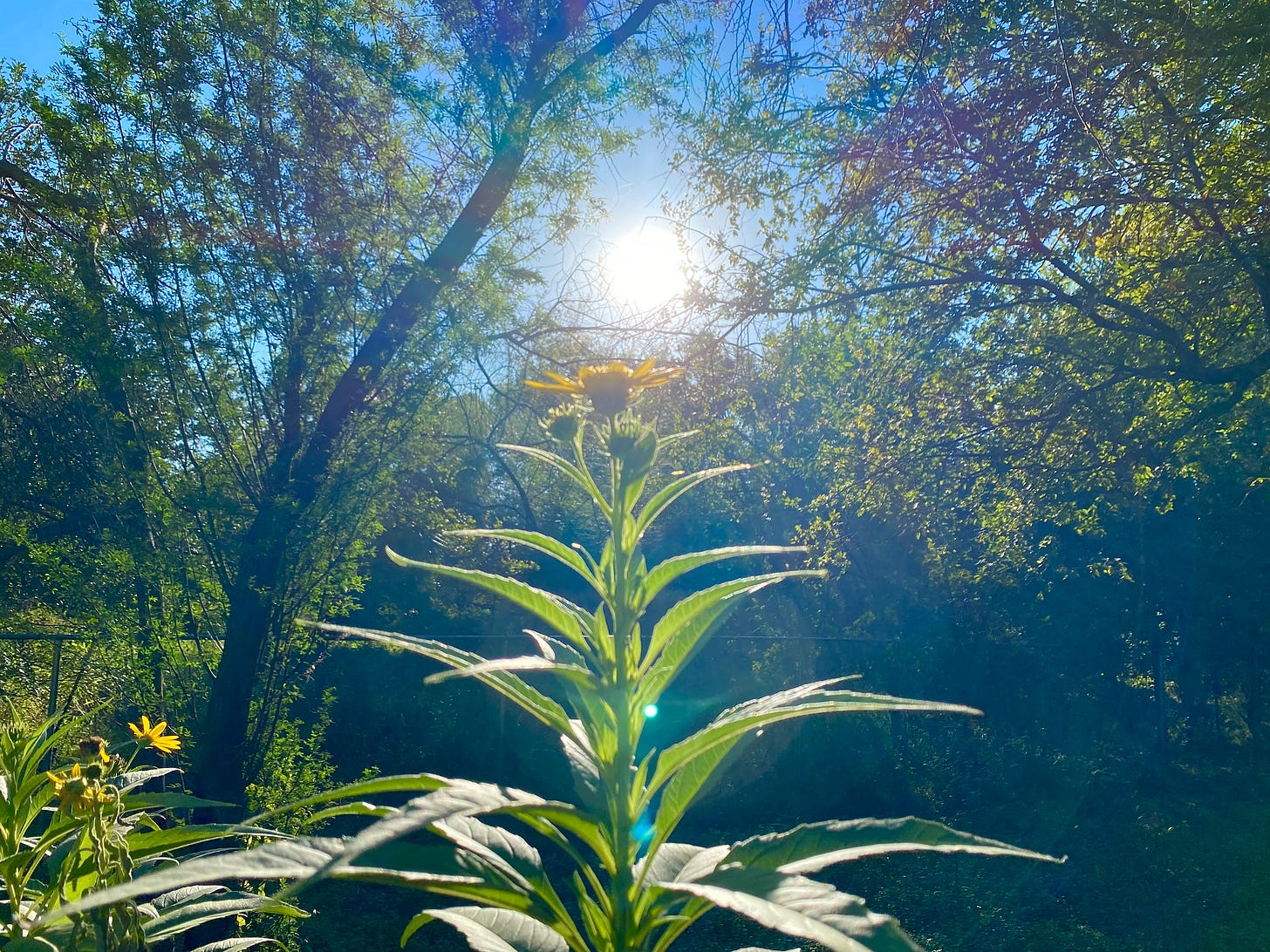

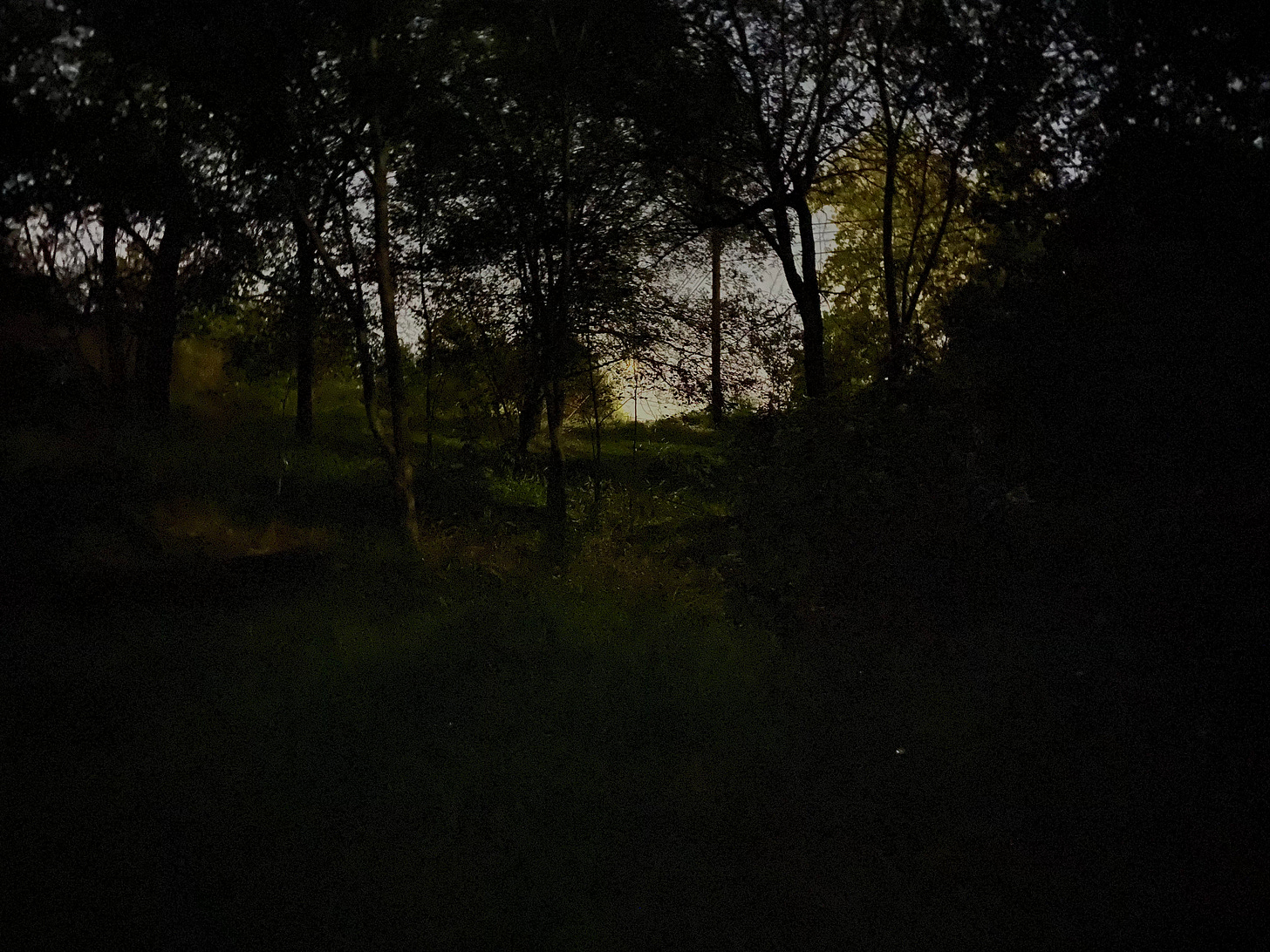


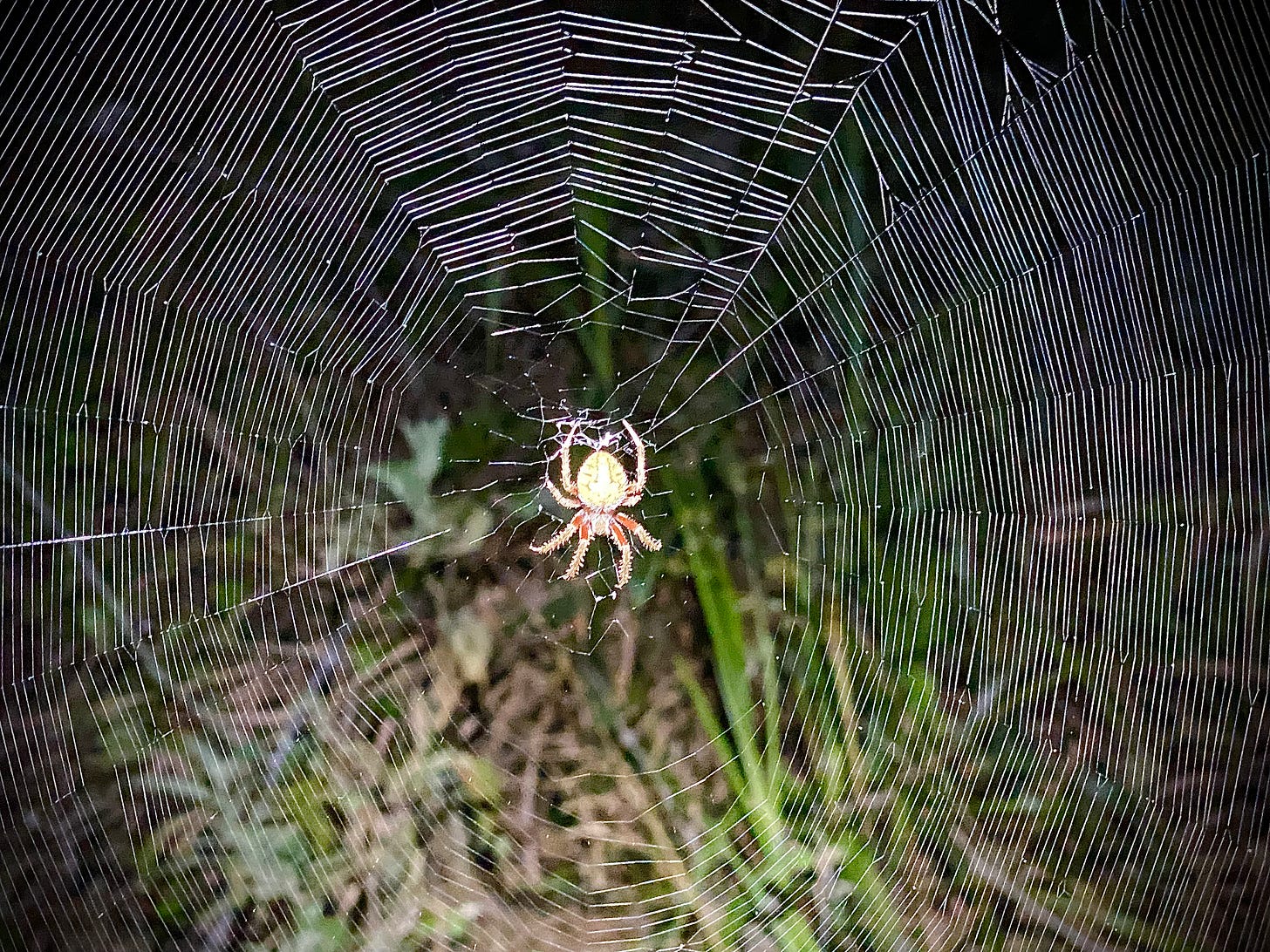




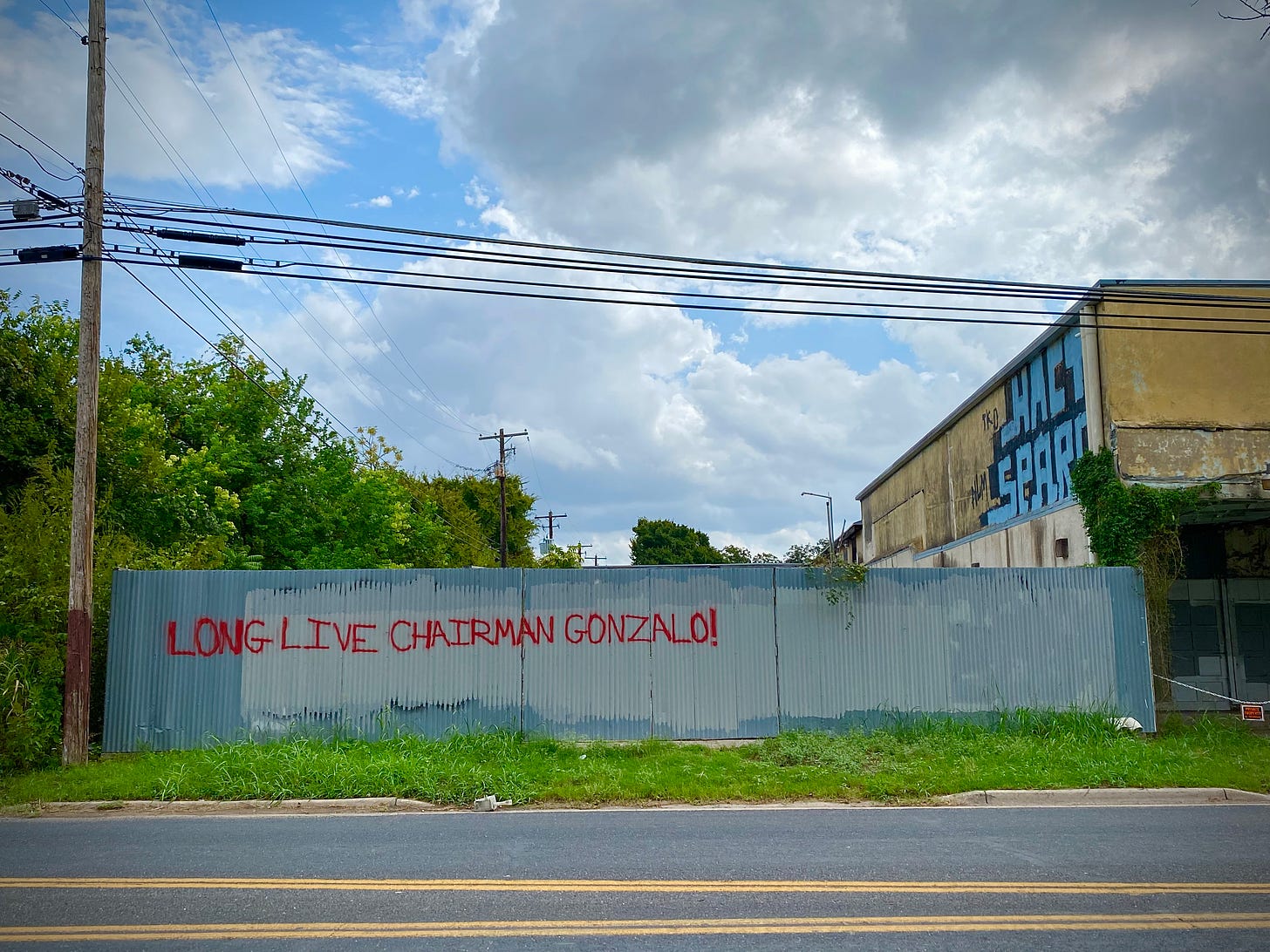
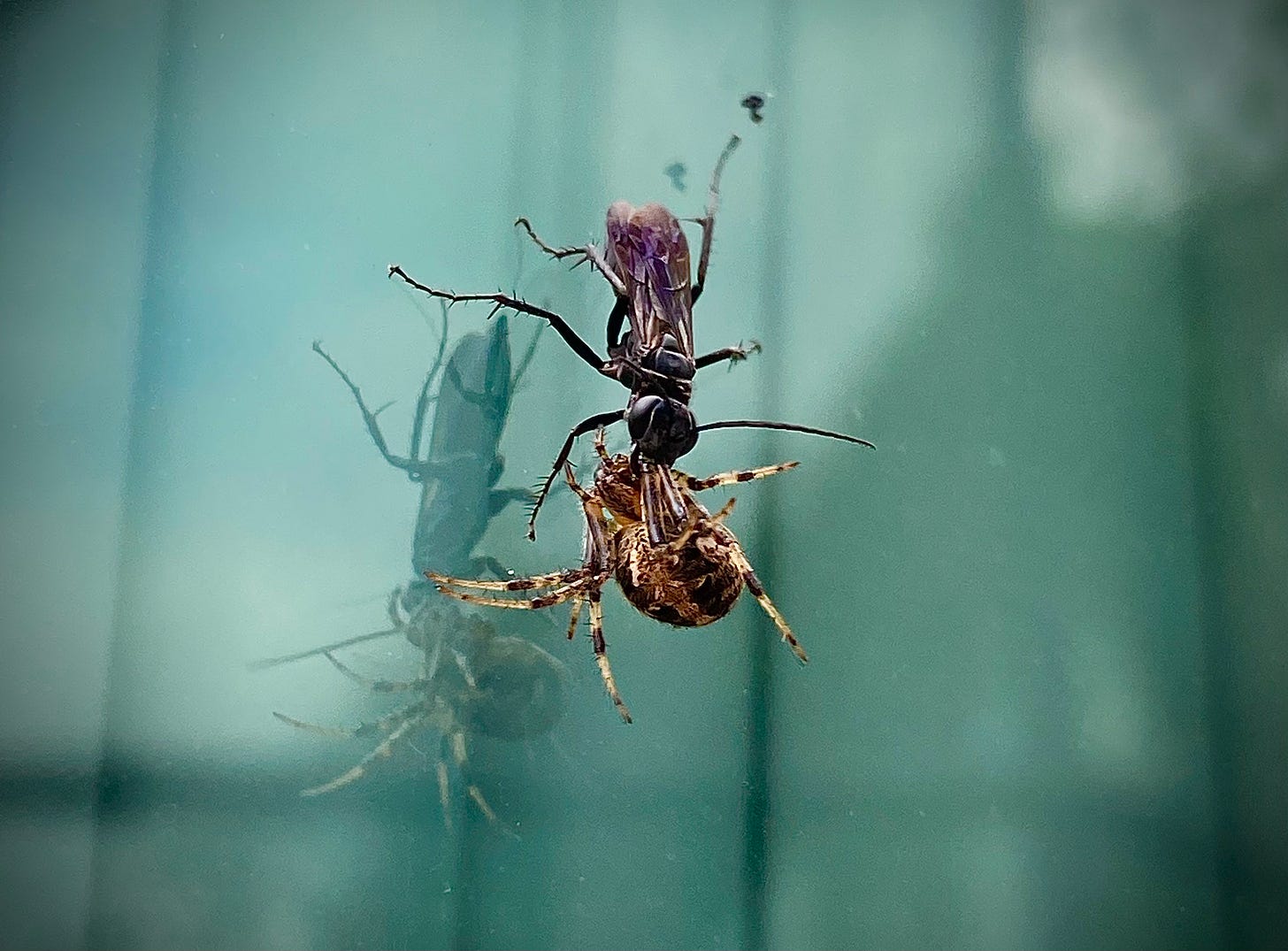
I have been taking walks this week at the oddest times of night, evening before the moon rises, 3 in the morning, and under a full moon at 7AM. The darkness before the moon rise is eerie, even though it is still early. I live across two roads from a small resort lake. There are plenty of weekender houses with no one home right around the lake but fields and small copses of woods around that. It is quiet and dark and you can hear the deer shifting around you. I love my full-moon walks but it’s my dark sky walks that intrigue me most. Intellectually, I know what’s out there, viscerally, not so much.
Another fascinating and great read Thanks.